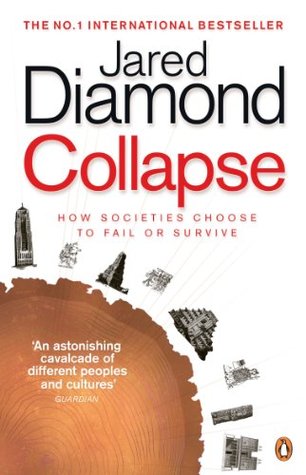More on this book
Community
Kindle Notes & Highlights
Read between
December 23, 2019 - January 6, 2024
A dozen miles south of Missoula is a long straight stretch of road where the valley floor is flat and covered with farmland, and where the snowcapped Bitterroot Mountains on the west and the Sapphire Mountains on the east rise abruptly from the valley.
At present rates of melting, Glacier National Park will have no glaciers at all by the year 2030.
“What did the Easter Islander who cut down the last palm tree say while he was doing it?” Like modern loggers, did he shout “Jobs, not trees!”? Or: “Technology will solve our problems, never fear, we’ll find a substitute for wood”?
Easter Island was as isolated in the Pacific Ocean as the Earth is today in space. When the Easter Islanders got into difficulties, there was nowhere to which they could flee,
Those are the reasons why people see the collapse of Easter Island society as a metaphor, a worst-case scenario, for what may lie ahead of us in our own future.
Despite these varying proximate causes of abandonments, all were ultimately due to the same fundamental challenge: people living in fragile and difficult environments, adopting solutions that were brilliantly successful and understandable “in the short run,” but that failed or else created fatal problems in the long run, when people became confronted with external environmental changes or human-caused environmental changes that societies without written histories and without archaeologists could not have anticipated. I put “in the short run” in quotation marks, because the Anasazi did survive
...more
Over the course of six centuries the human population of Chaco Canyon grew, its demands on the environment grew, its environmental resources declined, and people came to be living increasingly close to the margin of what the environment could support.
plaster—reminiscent in turn of the extravagant conspicuous consumption by modern American CEOs. The passivity of Easter chiefs and Maya kings in the face of the real big threats to their societies completes our list of disquieting parallels.
Iceland’s colonization began in earnest around the year 870 and virtually ended by the year 930, when
The breeding walrus colonies were quickly exterminated, and the breeding seabirds became depleted, leaving hunters to shift attention to seals.
At the time that settlement of Iceland began, one-quarter of the island’s area was forested. The settlers proceeded to clear the trees for pastures, and for using the trees themselves as firewood, timber, and charcoal. About 80% of that original woodland was cleared within the first few decades, and 96% as of modern times, thus leaving only 1% of Iceland’s area still forested (Plate 16
Once the original trees had been removed, grazing by sheep, and rooting by the pigs initially present, prevented seedlings from regenerating. As one drives across Iceland today, it is striking to notice how the occasional clumps of trees still standing are mostly ones enclosed by fences to protect them from sheep.
It seemed natural to the settlers to occupy the highlands and to stock many sheep there, just as they had in the Scottish highlands: how would they know that Iceland’s highlands couldn’t support sheep indefinitely,
When the settlers finally realized what was happening, they did take corrective action. They stopped throwing away big pieces of wood, stopped keeping ecologically destructive pigs and goats, and abandoned much of the highlands. Groups of
For several centuries Iceland was self-governing, until fighting between chiefs belonging to the five leading families resulted in many killings of people and burnings of farms in the first half of the 13th century. In 1262 Icelanders invited Norway’s king to govern them, reasoning that a distant king was less of a danger to them, would leave them more freedom, and could not possibly plunge their land into such disorder as their own nearby chiefs.
In 1874 Iceland achieved some self-government, home rule in 1904, and full independence from Denmark in 1944.
According to the sagas, the first Indians that the Vikings met were a group of nine, of whom they killed eight, while the ninth fled. That was not a promising start to establishing friendship. Not surprisingly, the Indians came back in a fleet of small boats, shot arrows at the Norse, and killed their leader,
“The greater the trials that you suffer at the hands of men, the greater will be your own merits and rewards.”
However, the number of independent farmers probably decreased with time as they were forced into becoming tenants of the chiefs, a process that is well documented in Iceland. We don’t have corresponding records for the process in Greenland, but it seems likely there too, because the forces promoting it were even more marked in Greenland than in Iceland. Those forces consisted of climate fluctuations driving poorer farmers in bad years into debt to richer farmers who lent them hay and livestock, and who could eventually foreclose on them.
the values to which people cling most stubbornly under inappropriate conditions are those values that were previously the source of their greatest triumphs over adversity.
It is difficult for us to acknowledge that people are not consistent, but are instead mosaics of traits formed by different sets of experiences that often do not correlate with each other.
“Adolf Hitler loved dogs and brushed his teeth, but that doesn’t mean that we should hate dogs and stop brushing our teeth.”
“The apocalypse here will not take the form of an earthquake or hurricane, but of a world buried in garbage.”
Increasingly, most Australians don’t depend on or really live in the Australian environment: they live instead in those five big cities, which are connected to the outside world rather than to the Australian landscape.


